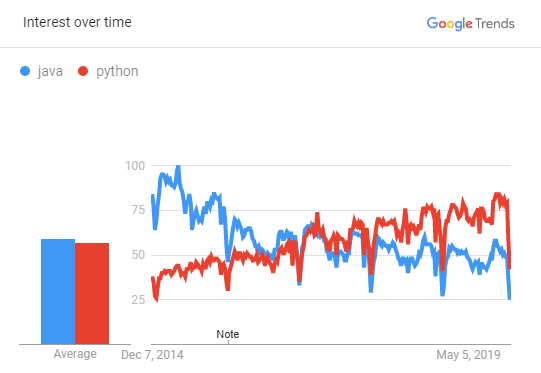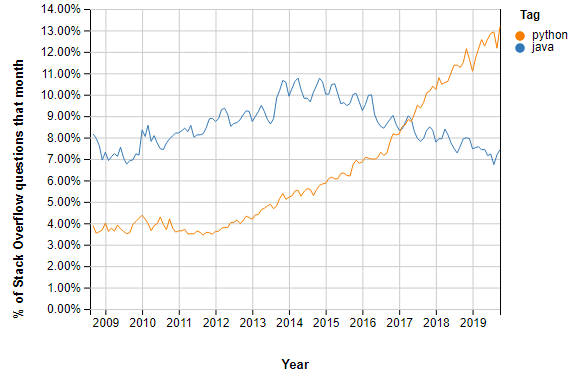Java Tutorials
Abstraction in Java | Abstract Class & Method with Example
What is Abstraction in Java? Abstraction in JAVA shows only the essential attributes and hides...
Java is a multi-platform, object-oriented, and network-centric, programming language. It is among the most used programming language. It also used as a computing platform, and it was first released by Sun Microsystem in 1995. It was later acquired by Oracle Corporation.
In this Java vs Python tutorial, you will learn:
Python is a high-level object-oriented programming language. It has built-in data structures, combined with dynamic binding and typing, which makes it an ideal choice for rapid application development. Python also offers support for modules and packages, which allows system modularity and code reuse.
It is one of the fastest programming languages as it requires very few lines of code. Its emphasis is on readability and simplicity, which make it a great choice for beginners.

Here, are benefits/ pros of using Java
Here, are important landmarks for Java language
Here, are important landmarks for Python language
Here are the important features of Java.

Here are the important features of Java.
Here, are important features of Python
Here, are the main differences between Java and Python
| Parameter | Java | Python |
|---|---|---|
| Compilation | Java is a Compiled Language | Python is an Interpreted Language |
| Static or Dynamic | Java is statically typed | Python is dynamically typed |
| String operations | Offers limited string related functions. | It offers lots of string related functions. |
| Learning curve | Complex learning curve | Easy to learn and use |
| Multiple inheritances | Multiple inheritances is partially done through interfaces. | It offers both single and multiple inheritances. |
| Braces vs. Indentation | It uses curly braces to define the beginning and end of each function and class definition. | Python uses indentation to separate code into code blocks. |
| Speed | Java program runs slowly compared to Python. | Python programs run faster than Java. |
| Portability | Any computer or mobile device which is able to run the Java virtual machine can run a Java application | Python programs need an interpreter installed on the target machine to translate Python code. Compared to Java, Python is less portable. |
| Read file | Java takes 10 lines of code to read from a file in Java. | Python only needs 2 lines of code. |
| Architecture | Java Virtual Machine provides the runtime environment to execute the code and convert bytecode into machine language. | For Python, the interpreter translates source code into machine-independent bytecode. |
| Backend Frameworks | Spring, Blade | Django, Flask |
| Machine Learning Libraries | Weka, Mallet, Deeplearning4j, MOA | Tensorflow. Pytorch. |
| Game Development Engines | JMonkeyEngine | Cocos. Panda3d |
| Famous companies using this technology | Airbnb, Netflix, Spotify, Instagram. | Uber, Technologies, Dropbox, Google. |
| Best features |
|
|
| Best use for | Java is best for Desktop GUI apps, Embed Systems, Web application services, etc. | Python is excellent for scientific and numeric computing, Machine learning apps, more. |
| Database support | Java offers stable connectivity | Python offers weak connectivity. |
| Code example | class A {
public static void main(String args[]){
System.out.println("Hello World");
}
}
| Hello World in Python: print "hello world"; |
| TIOBE Rating | 1 | 3 |
| Companies using it | Docker, Android SDK, Spring Boot, Senty,etc. | Django, Flask, Pycharm, CircleCI, etc. |
| Salaries | The average salary for a Java Developer is $103,464 per year in the United States. | The average salary for a Python Developer is $118,626 per year in the United States. |
Here, are cons/drawback of using Java language
Here, are cons/drawback of using Python language
Python is an ideal choice for beginners as the language is more intuitive, and its syntax is very much similar to the English language. Its open-source nature facilitates a slew of new tools that improve it.
On the other hand, Java is a general-purpose programming language that was designed with a specific goal of allowing developers to write once run anywhere.
Selection one language among these ultimately comes down to the nature and the cost of the development project.
What is Abstraction in Java? Abstraction in JAVA shows only the essential attributes and hides...
What is JavaScript? JavaScript is a scripting language which helps you create interactive web...
In this example program, we will reverse a string entered by a user. We will create a function to...
What is Constructor in Java? CONSTRUCTOR is a special method that is used to initialize a newly...
What is Fibonacci Series? In Fibonacci series, next number is the sum of previous two numbers. The...
We all use switches regularly in our lives. Yes, I am talking about electrical switches we use for our...